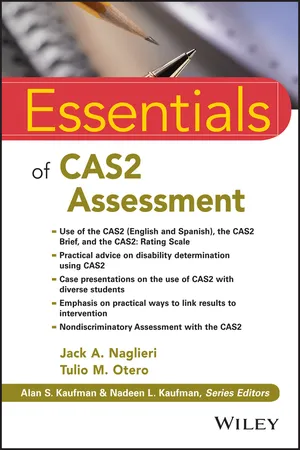
Essentials of CAS2 Assessment
Jack A. Naglieri, Tulio M. Otero, Alan S. Kaufman, Nadeen L. Kaufman
- English
- ePUB (apto para móviles)
- Disponible en iOS y Android
Essentials of CAS2 Assessment
Jack A. Naglieri, Tulio M. Otero, Alan S. Kaufman, Nadeen L. Kaufman
Información del libro
The definitive guide to the latest edition of the Cognitive Assessment System
Essentials of CAS2 Assessment is a comprehensive guide to the successful administration of the updated CAS2. Written by leading cognitive assessment experts, the book discusses the latest research and thinking on PASS (Planning, Attention-Arousal, Simultaneous and Successive) theory and includes case studies that demonstrate the use of CAS2 with several types of diagnostic groups and integration with other instruments. A companion website offers additional tools andinformation to help busy professionals make optimal use of the CAS2.
This is the first book to provide comprehensive, step-by-step guidelines for administering, scoring, and interpreting the latest edition of the Cognitive Assessment System (CAS2). While the outcome of the test depends upon the child's performance, the reliability and accuracy of the analysis depends largely upon the performance of the test administrator. Essentials of CAS2 Assessment offers detailed insight on topics such as:
- Fair assessment of diverse populations
- Assessment of children with comorbid conditions
- Changes to the CAS2 rating scale and form
- Nuances of the three-tier model
Each chapter in the book highlights key concepts, bulleted points, and actual test questions. The CAS2 is a valuable tool in the detection of learning disabilities, ADHD, TBI, retardation, and giftedness. Essentials of CAS2 Assessment is the guidebook professionals need to ensure the CAS2 test is applied and analyzed accurately so that the results can be applied to the maximum benefit of the child.
Preguntas frecuentes
Información
Chapter One
OVERVIEW
DON'T FORGET 1.1
Rapid Reference 1.1
Stanford‐Binet Scales
| 1905 | First Binet scale is published by Binet and Simon, subsequently revised in 1908. |
| 1909 | Goddard translates Binet‐Simon from French to English. |
| 1916 | Terman publishes the Stanford revision and extension of the Binet‐Simon scale that is normed on American children and adolescents and is widely used. |
| 1937 | Terman and Merrill publish a revision of the 1916 scale called the Stanford‐Binet Intelligence Scale. |
| 1960 | Stanford‐Binet, Form LM (Second Edition) |
| 1972 | Stanford‐Binet, Form LM (Third Edition) |
| 1986 | Stanford‐Binet, Fourth Edition (by Thorndike, Hagen, & Sattler) |
| 2003 | Stanford‐Binet, Fifth Edition |
Rapid Reference 1.2
Wechsler Scales
| 1939 | Wechsler‐Bellevue, Form I |
| 1946 | Wechsler‐Bellevue, Form II |
| 1949 | Wechsler Intelligence Scale for Children (WISC) |
| 1955 | Wechsler Adult Intelligence Scale (WAIS) |
| 1967 | Wechsler Preschool and Primary Scale of Intelligence |
| 1974 | WISC‐Revised |
| 1981 | WAIS‐Revised |
| 1989 | WPPSI‐Revised |
| 1991 | WISC‐III |
| 1997 | WAIS‐III |
| 2003 | WISC‐IV |
| 2008 | WAIS‐IV |
| 2014 | WISC‐V |